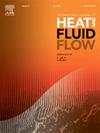Magnetohydrodynamic instability in a partially heated vertical channel
IF 2.6
3区 工程技术
Q2 ENGINEERING, MECHANICAL
International Journal of Heat and Fluid Flow
Pub Date : 2024-12-01
DOI:10.1016/j.ijheatfluidflow.2024.109661
引用次数: 0
Abstract
The linear stability and the nonlinear behavior of a two-dimensional magnetohydrodynamic (MHD) opposing mixed convection flow of an electrically conducting fluid mixture in a partially and symmetrically heated vertical channel of finite length under an applied transverse magnetic field is studied using numerically generated perturbed functions. The problem depends on the following dimensionless parameters of the fluid mixture: the flow Reynolds number (), the Prandtl number (), the Richardson number (), and the Hartmann () number, together with geometrical parameters of the vertical channel. The nonlinear behavior is studied by solving numerically the full nonlinear equations and employing a temporal asymmetric perturbation of the number. The nonlinear stability results show that for relatively large values of the number, the flow is stable and the evolution of the heat transfer response is symmetric. For decreasing values of the number, for a critical value of , symmetry breaks and a stable nonsymmetric flow and heat transfer response is reached. Our findings reveal the existence of a hysteresis loop describing the nonlinear behavior for the resulting evolution of the overall Nusselt numbers at different numbers. A linear stability analysis using a symmetrical non-parallel thermal base flow has also been performed for the same parameter values. The symmetric flow system shows instability for a critical value of , where the vertical separation of the two vortical structures oscillates with a fixed dimensionless frequency of . The results show that the nonlinear behavior using the full nonlinear equations reveals hidden instability for the linear analysis. Furthermore, we demonstrate that for the chosen set of parameters and at sufficient high values of the number, the complex interactions related to the effects of shear, opposing buoyancy, and magnetic damping can be effectively used to stabilize the flow.
求助全文
约1分钟内获得全文
求助全文
来源期刊

International Journal of Heat and Fluid Flow
工程技术-工程:机械
CiteScore
5.00
自引率
7.70%
发文量
131
审稿时长
33 days
期刊介绍:
The International Journal of Heat and Fluid Flow welcomes high-quality original contributions on experimental, computational, and physical aspects of convective heat transfer and fluid dynamics relevant to engineering or the environment, including multiphase and microscale flows.
Papers reporting the application of these disciplines to design and development, with emphasis on new technological fields, are also welcomed. Some of these new fields include microscale electronic and mechanical systems; medical and biological systems; and thermal and flow control in both the internal and external environment.
 求助内容:
求助内容: 应助结果提醒方式:
应助结果提醒方式:


